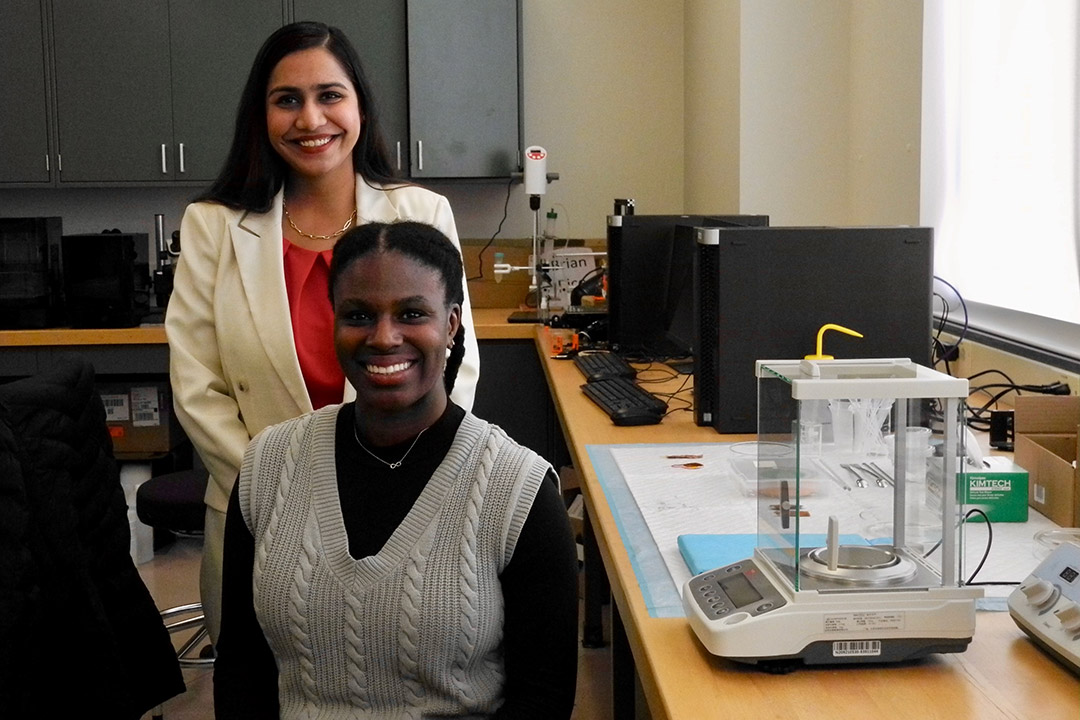Student spotlight: Fine tuning a sense of touch
Undergraduate Leila Daly helps further sensor technology to improve touch in prosthetics
Provided
Leila Dal, seated, is working with Krittika Goyal, an assistant professor in the College of Engineering Technology, to improve touch sensors for prosthetics.
Fine tuning sensors on prosthetics includes incorporating the sense of touch into a device to be as close to the sensations felt by a natural limb as can be.
Leila Daly, a fifth-year computer engineering technology student from Willingboro, N.J., is working with Krittika Goyal, an assistant professor of mechanical engineering technology in RIT’s College of Engineering Technology, on developing a sensor system for a more touch-responsive prosthetic finger.
The two began working together last semester after Daly took a control systems class from Goyal. She expressed interest in Goyal’s prosthetics research, and the initial few hours a week working in her lab last spring became an on-campus co-op this fall.
“It’s only been a couple of months and now we have a proof of concept. We are at the stage of fine tuning this, optimizing it, so Leila is testing the fabricated sensor she made. This is phase one,” said Goyal ‘23 (microsystems engineering), who is an expert in bio-sensing technologies.
Projects like prosthetics improvements are MAD—Making A Difference—a phrase Goyal uses to describe how theory and tech can be applied for real-world solutions. Daly related to the sentiment. Here she describes her experiences building this first phase of a more responsive prosthetic finger and how it inspired her to seek a career in the medical technology industry.
Describe the prosthetics project and the technology you are developing?
We are working on the fabrication of a piezoelectric sensor being designed for prosthetic applications. The goal to have a prosthetic finger with this material printed onto it and then have that act as a touch sensor on the prosthetic finger. We are using the combination of two chemicals, one with what is known as piezoelectric properties, which means this sensor responds to mechanical strain with a readable electrical signal. The idea is, if you touch it, you can read the voltage signal. Not only would the user be able to detect they are touching something, but how much force they are applying to whatever it is they are touching. The example I use when I am explaining it to people is the amount of force you would use to hold your child’s hand versus lifting a heavy object.
How did you begin this work and where are you in the process?
Dr. Goyal and I researched extensively on how chemicals interact in the composite mixture. Our overall goal is to combine the research and create something new. Currently, I am curing materials now to see how they perform as a solid form. I’m also applying a layer of conductivity around it, a silver ink to measure voltage, and around that I have another layer of insulating material to ensure that everything is electrically secure.
How are you implementing your ideas for the prosthetic?
The idea is that the material is used in a liquid state, the first is the piezoelectric material, and this one gives off the electrical signal that gives off the response of touch. A second one provides elasticity to that mixture. Piezoelectric material is very brittle and powder-like. The other material adds in the flexibility and mobility needed for testing. The idea is to use that material in its liquid state, then apply it to the finger (device).
How can work like this help prepare you for the workplace?
The combination of every single internship and research experience has helped me significantly. I would say with every new opportunity, I pick up a new technology skill and a “soft” skill, whether that’s learning to speak up more, to collaborate with others, or how to give a presentation. It’s skills you may not learn directly from classes, but they are essential in getting a job and being able to work with others in a communal environment. It is also important to see a large project that in its entirety may look overwhelming—and you need to learn how to break it down into smaller, more achievable goals.
What would you like to see come out of this project?
I am very passionate about this project. This definitely inspired me to want to go into the biomedical field, even though my background is in coding. I would love to be able to program some aspects of medical device technology. I would love to do that specifically for this project. I hope to do this next semester, and I can see how far it evolves before I graduate.
